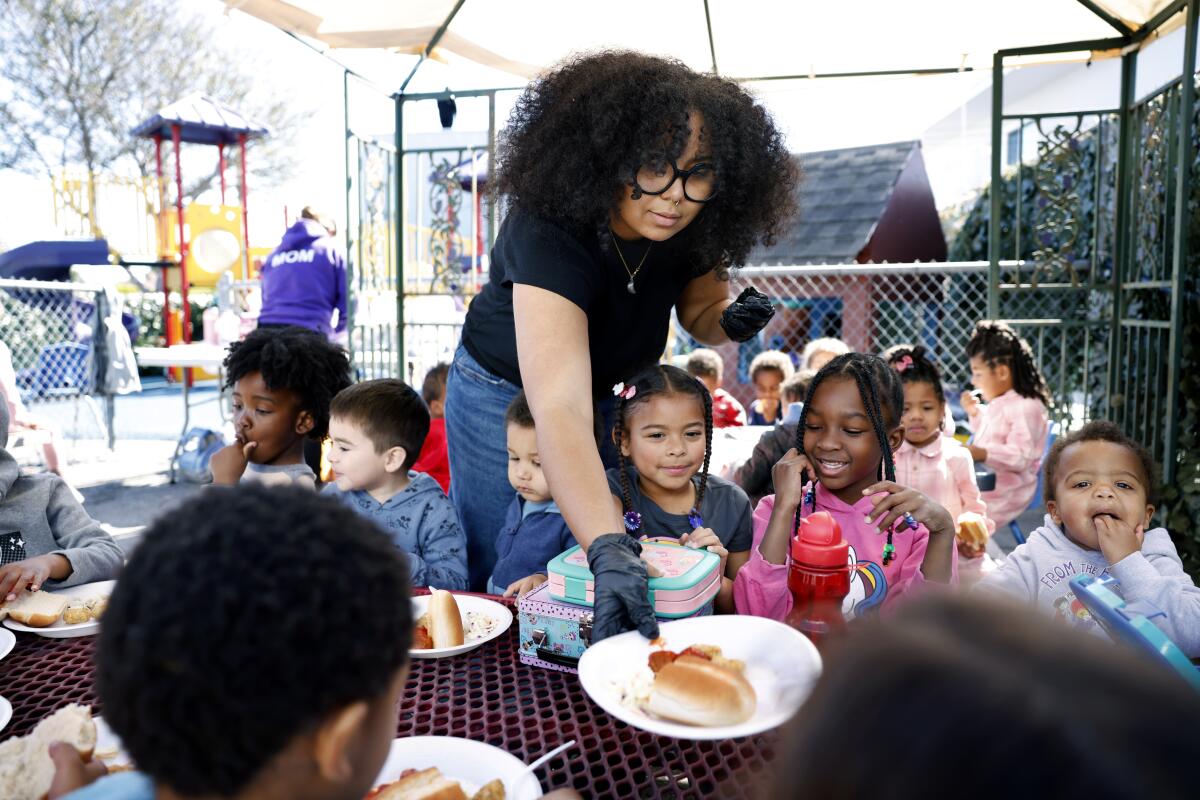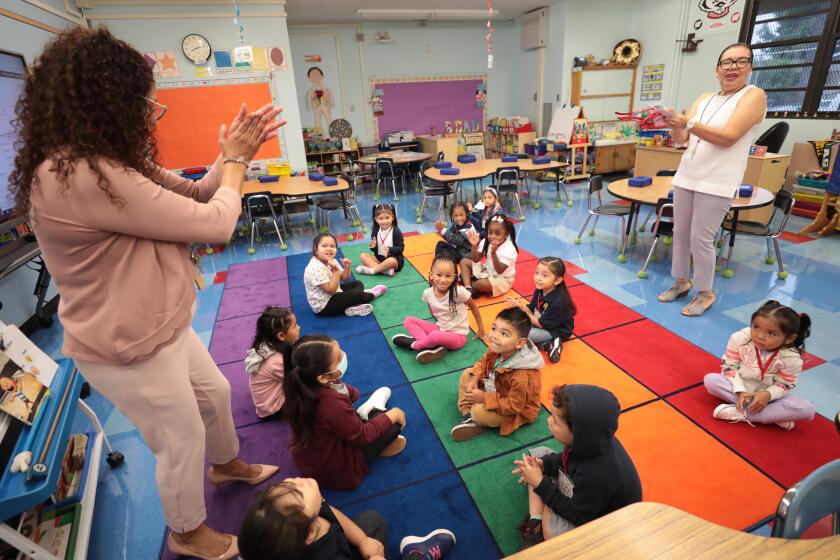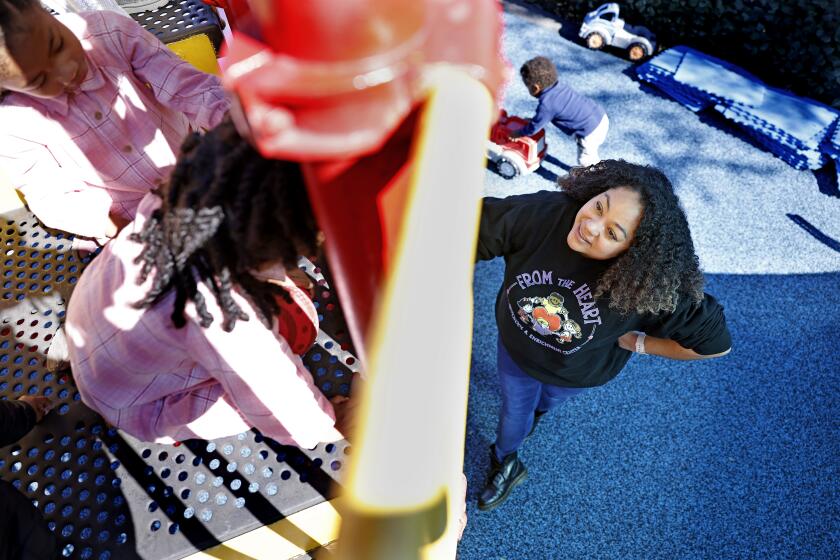L.A. child-care industry in tailspin, hit with disruption as transition kindergarten grows

DIG Childhood Center in Mar Vista once had no problem filling all 36 of its slots with eager young learners, who romped barefoot in a play yard filled with vegetables, monarch butterflies and a small stream. Before the pandemic, there was even a wait list.
But after a student exodus in 2020, the once-popular preschool has yet to recover. Enrollment is down to 22 students, with no signs of a rebound. This year, director Nina Moench said, she’s losing seven students to transitional kindergarten — the state’s rapidly expanding new grade for 4-year-old public school children. Other families are moving out of state, pushed out by the rising cost of living in Los Angeles County.
“Every school I talk to is struggling,” she said. “I’m just hoping everything will swing back the other way.”
More than four years after the start of the pandemic, the child-care industry in Los Angeles County is reeling from a dramatically shifting landscape and new options for parents, early childhood experts said. Students are leaving preschool for transitional kindergarten classrooms; an influx of state-funded vouchers can be used for a variety of care options; the population is declining. More flexible employment arrangements and teacher shortages also are contributing to the disruption.
But in a frustrating situation for new parents, the number of child-care slots for infants and toddlers still falls woefully short of the need.
Engage with our community-funded journalism as we delve into child care, transitional kindergarten, health and other issues affecting children from birth through age 5.
A new report from UC Berkeley provides data showing the number of unfilled slots for 3- and 4-year-old children at L.A. County preschools has continued to rise, from 21,000 in March 2021 to 28,000 in June 2024. State preschools that serve low- and middle-income families earning less than $113,292 a year for a family of four have been hit the hardest, with enrollment down 35% compared with pre-pandemic levels. And statewide, Head Start enrollment has collapsed to less than half of what it had been.
Transitional kindergarten, known as TK, has been more of a bright spot. The program was launched in 2012, and in the 2022-23 school year, Gov. Gavin Newsom’s administration began expanding it to serve all 4-year-olds in the state. TK enrollment dropped 32% during the pandemic, but bounced up to 23,253 students in the fall of 2023 — and probably will grow in the coming years as more students become eligible for the program. Yet despite encouraging growth, TK enrollment remains about 15% below pre-pandemic levels even with increases in eligibility, the UC Berkeley report said.
“The sector is still struggling to get back on its feet,” said Bruce Fuller, a UC Berkeley professor of education and public policy and an author of the report, though there are myriad factors contributing to the disruption, he and other experts said.
As California public school enrollment declines again, state officials look to transitional kindergarten growth as a promising development.
Some of the empty slots might actually reflect a lack of teachers, rather than family interest. In certain schools, for example, there are “dark classrooms” where they might be able to serve additional students but haven’t been able to hire teachers to staff them.
Many parents found alternative care arrangements during the pandemic, including keeping children at home, Fuller said — and they now have a growing array of options. California has not only bolstered TK, but also released nearly 100,000 new vouchers for non-welfare families over two years that enable low-income parents to send their children to family child-care homes or child-care centers, or use them to pay a friend or family member for care.
The number of non-welfare families receiving vouchers in L.A. County has more than doubled to 27,836 since 2022. Cristina Alvarado, executive director of Child Care Alliance Los Angeles, said vouchers have been a particularly popular option among parents in hybrid work arrangements. Even with the influx of vouchers, there are still waiting lists of parents seeking the flexible option.
Find expert tips, must-read books and local resources to help your child get hooked on reading.
But some children enrolled in new voucher slots or TK may have left a preschool or child-care center.
“Is the Newsom administration really widening access for families, or are we just shuffling 4-year-olds among programs?” Fuller said. “This report suggests that enrollment rates are the same; it’s just that the same kids are going to different programs.”
This shuffling probably explains much of the decline in state preschool enrollment, said Nina Buthee, executive director of EveryChild California, a membership association for child-care centers. About 68% of state preschool classrooms are run by school districts and located on elementary school campuses. Many 4-year-old students have simply transferred over to the TK classroom next door.
The state has tried to make up for these losses by offering state preschools higher reimbursement rates to enroll 3-year-olds instead. But these younger children have proved difficult to recruit, Buthee said. “Programs are absolutely trying to, but parents aren’t taking them up on it.”
As various programs compete for 4-year-old students, the shortage of day-care openings for infants and toddlers remains dire.
In L.A. County, there are only enough licensed slots to serve 4% of children younger than 24 months, according to a report from the county Office for the Advancement of Early Care and Education. In an ideal situation, child-care providers unable to recruit enough older students could simply admit more babies instead, but the reality of making this transition has been a challenge.
Infants require additional staffing. Transitioning from caring for a 4-year-old to an infant or toddler isn’t necessarily a smooth one, said Lisa Wilkin, executive director of the Child Development Consortium of Los Angeles, which runs 10 centers that serve a mix of babies, toddlers and preschoolers. Younger children require more support in diapering and self-help skills such as self-regulation.
“A lot of people who work with preschoolers, they feel like that’s a teacher position. And the people who work with infants and toddlers — including 2-year-olds — as caregivers,” Wilkin said. “Even with the same qualifications.”
Black and Latina child-care workers are paid less and given fewer leadership roles than their co-workers, despite making up much of the early childhood workforce.
Licenses for infant care also have different requirements than they do for older kids, meaning that providers may have to change playground equipment, furniture and toys. Bathrooms may not be large enough to accommodate a changing table. And classrooms may require new smoke detectors and sprinklers, which can be cost prohibitive, Wilkin said.
Some providers are working on solutions to the infant care shortage, and a recent policy change now allows state preschools to serve 2-year-olds.
One center at the Child Development Consortium of Los Angeles converted a preschool classroom to one for 2-year-olds. The consortium is also subcontracting with family child-care providers to serve more babies, because it doesn’t have enough licensed infant slots.
For Rose Witmer and Nick Dossman, getting their 2-year-old son, Miles, into an Early Head Start center took months. He started out in Head Start’s home-based program and spent nine months on a wait list before getting into a center run by Garvey School District in April. Dossman even joined the program’s parent committee in the meantime, on the off chance that it would help their son’s chances.
The wait was well worth it, Witmer said.
“It’s been such an amazing program,” she said. “Really within a couple months, I would say, his language just shot through the roof — the vocabulary he was using, the amount of thoughts he was able to communicate was kind of amazing.”
This article is part of The Times’ early childhood education initiative, focusing on the learning and development of California children from birth to age 5. For more information about the initiative and its philanthropic funders, go to latimes.com/earlyed.
More to Read
Sign up for Essential California
The most important California stories and recommendations in your inbox every morning.
You may occasionally receive promotional content from the Los Angeles Times.
















